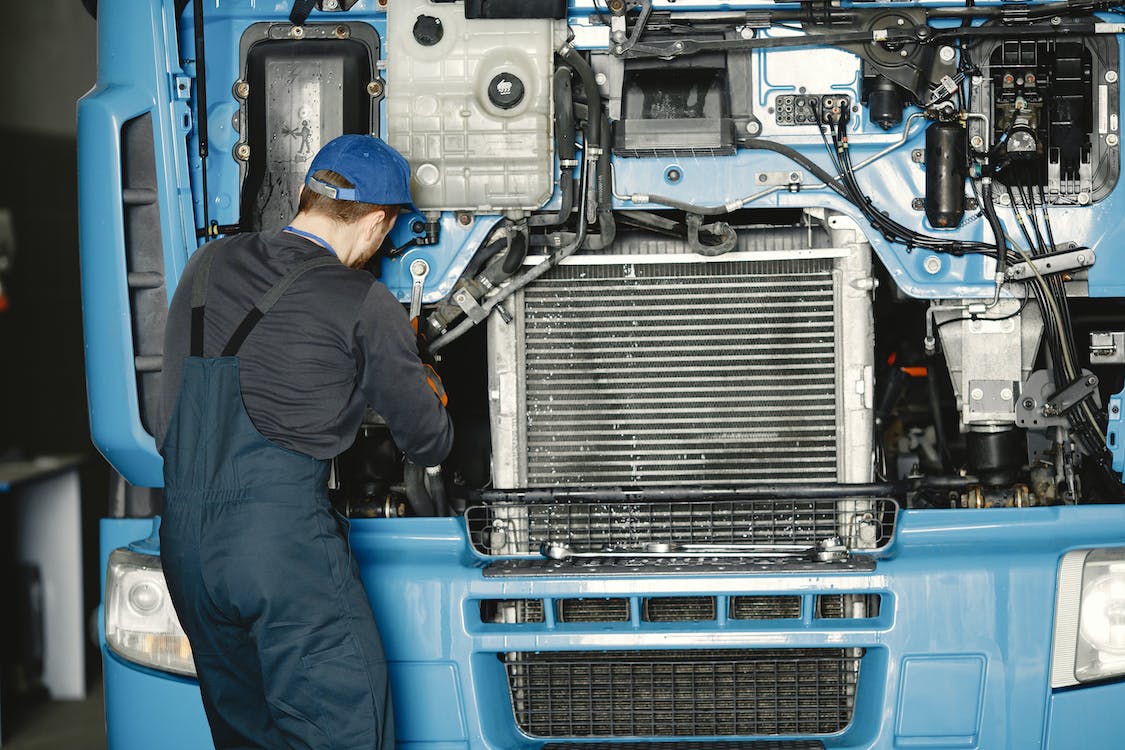The Road to Successful Fleet Maintenance
The Road to Successful Fleet Maintenance
.png)
The health of your fleet determines the health of your business. Breakdowns, struggling systems, and costly repair fees can sap your earnings dry if they arise too often. Regular preventative maintenance is essential for all fleet owners as it helps ensure all systems are functioning properly and prevents costly repair jobs that can arise if your truck goes too long in between check-ups.
Fleet managers and maintenance supervisors must create a regular maintenance checklist and timeline to ensure the long-term health of their fleet. Otherwise, trucks can be decommissioned for long periods. Or, worse, many of your fleet’s trucks can face the same issue, and your business can creep to a standstill until they are repaired.
Regular maintenance ensures safety, efficiency, and longevity for the vehicles in your fleet. In this post, we will provide:
- A comprehensive fleet maintenance checklist
- Details on the importance of regular maintenance
- Types of fleet maintenance
- How to construct a fleet meant for long-term health
Keep reading to learn more so you can save your business serious time and money.
The Importance of Fleet Maintenance
The road to successful fleet maintenance does not have to be a difficult one. In fact, you can keep your fleet mostly healthy and functioning all year round with a little bit of organization and planning.
Healthy fleets are those that have been taken care of regularly and have their parts replaced when they begin showing signs of wear. Health fleets also are composed of trucks with histories of durability under heavy duress.
Regular fleet maintenance will keep your trucks working at top capacity for years to come. In the next section, we will explore some different types of fleet maintenance that you can experiment with.

Different Types of Fleet Maintenance
Many businesses that use fleets usually have their trucks perform the same tasks. This means that your trucks will usually experience wear and tear in the same ways as one another.
However, this is not always the case. Some businesses have each truck in their fleet performing different operations. For example, some trucks may regularly be asked to drive cross-country loads while others need only to drive a few miles down the road and back.
Be aware of the different strains your trucks face and schedule maintenance accordingly. Trucks that see daily use may need to be checked every month. Alternatively, trucks that are rarely used might only need to be looked at once per year.
New or used flatbed truck, which is right for you? This guide has the answer!
Also, be aware of the age of your trucks. Older trucks will likely have systems that need to be replaced or repaired regularly. Meanwhile, newer models will need regular preventative maintenance.
- Corrective maintenance is fleet maintenance that is right for those trucks that have larger issues that are affecting performance. Corrective maintenance is designed to locate, isolate, and rectify any faults. This is best for trucks that have recently experienced issues that hindered performance.
- Preventative maintenance is better for trucks with a history of health and top performance. Preventative maintenance takes a holistic look at the truck and identifies wear and tear that may lead to larger issues down the line.
The Role of Preventative Maintenance in Fleet Management
Regular preventative maintenance is the best way to ensure the efficient and productive operation of your trucks for shipping or hauling needs. Maintenance from a reputable technician, even if there is nothing visibly wrong with the vehicle, can uncover soon-to-be issues and rectify them before they become problems.
Here are seven reasons preventative maintenance is key for your business.
- Cost Reduction: Regular preventative maintenance helps to identify and fix minor issues before they turn into major problems. This can significantly reduce overall maintenance costs by preventing the need for extensive repairs and replacements.
- Minimizing Downtime: Scheduled maintenance helps to keep vehicles and equipment in optimal working condition, reducing the likelihood of unexpected breakdowns and minimizing downtime. This is especially important for businesses that rely on their fleet to provide services or deliver goods.
- Extending Lifespan: Proper maintenance can extend the lifespan of vehicles and equipment, allowing them to remain operational and productive for a longer period. This can delay the need for costly replacements and help companies make the most of their investments.
- Safety and Compliance: Regular maintenance ensures that vehicles are safe to operate and compliant with relevant regulations. This is particularly important for industries with strict safety and environmental standards, such as transportation and logistics.
- Improved Fuel Efficiency: Well-maintained vehicles tend to operate more efficiently, leading to better fuel economy and reduced operational costs over time.
- Enhanced Resale Value: Fleet vehicles that have a documented history of preventative maintenance are often more attractive to potential buyers or lessees. This can lead to higher resale or trade-in values.
- Optimized Performance: Preventative maintenance helps maintain consistent performance levels, ensuring that vehicles and equipment operate at their best and deliver the desired results.
This post covers the most common truck failures on the road and your guide to fixing them!
Preventative Maintenance Checklist
Preventative maintenance checklists are key for keeping your fleet on the road and operating at peak efficiency.
The following list includes many of the essentials that vehicles require for longevity and health. Run through this list regularly. The amount your business uses in its fleet will determine how often your trucks will need to be checked. Be sure to check the recommendations provided by the vehicle manufacturer before maintenance.
Your Preventative Maintenance Checklist
- Check and change your engine oil.
- Check and change your transmission fluid.
- Inspect the fuel system.
- Inspect the cooling system.
- Inspect engine system and mount.
- Inspect the transmission system and mount.
- Inspect the drive shaft, CV joints, belts, and hoses for signs of wear.
- Inspect the electrical system.
- Inspect braking components.
- Inspect steering and suspension.
- Rotate and inspect tires, wheels, and rims.
- Inspect the exhaust system.
- Inspect the undercarriage and frame.
- Inspect all lights.
- Inspect the body, glass, and mirrors.
- Check the windshield wipers and refill the fluid.
- Check seat belts, and horn for function.
The above list is a rough guide for a preventative maintenance checklist for your fleet of trucks. Depending on the number, brand, variety, and functionality of your trucks, you may need to add or take away list items for a better result.
The Importance of Driver Observations in Fleet Maintenance
When it comes to keeping your fleet healthy, your drivers are one of the most important resources you have. They have an up-close and personal view of how the truck is performing, and they can alert you of any issues or failings they experienced on the road.
Be sure to check in with your drivers after each trip to inquire about any oddities or failures on the road. The driver's feedback can be very important. Your drivers have a lot of experience driving commercial trucks and they can quickly identify issues that may be missed in a regular check-up.
You can think of your drivers as your second line of defense when it comes to keeping your fleet in working order. Be sure that you are incorporating discussions with your drivers into your regular maintenance routine for the best results in the long run.
Implementing a Preventative Maintenance Checklist
The last step for long-term health and performance for your fleet is to implement your preventative maintenance checklist. This can be a difficult challenge, especially if your business already has an established routine, but if done successfully, a regular checklist can save your business significant time and money.
It all starts with communication. Set aside some time and have a conversation with management about reviewing your preventative maintenance checklist. Emphasize that a better checklist could save the business both time and money and point out some areas where your team could improve.
Next, present the checklist and have an open conversation with both management and your drivers about the necessary list items and the areas they feel need the most attention.
Last, implement the checklist into your routine. Determine how often your fleet needs preventative maintenance and stick with it. In the long run, this process will keep your trucks on the road for years to come.
Regular Fleet Maintenance with Beamers Piggyback
Regular preventative maintenance is one of the best things you can do to ensure that your fleet is healthy and road-ready for years to come. However, you need to take your trucks to reputable technicians who understand the importance of each part of your truck.
Don’t just trust anyone. Choose the experienced pros at Beamers Piggyback in the greater Cincinnati area!
The technicians at Beamers Piggyback have years of experience and we are proud to handle fleet maintenance for a wide variety of brands and models.
Contact us today to learn more about preventative maintenance strategies and how we can get your fleet on a preventative maintenance program today! Click here!
Follow Beamers Piggyback on Facebook and Instagram for more free trucking tips!
Happy with the difference we made for your fleet? Leave us a five-star review here!

.png)